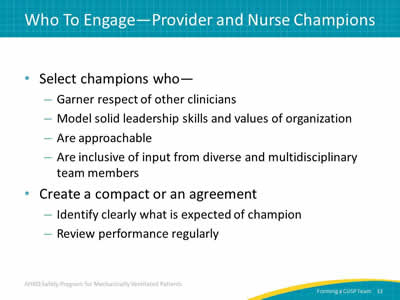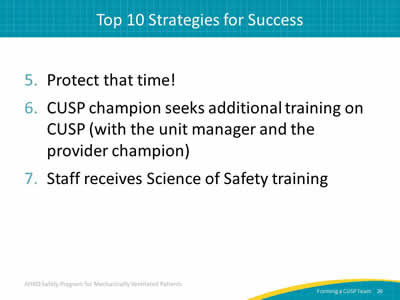Forming a Comprehensive Unit-based Safety Program Team: Slide Presentation
AHRQ Safety Program for Mechanically Ventilated Patients
Slide 1: AHRQ Safety Program for Mechanically Ventilated Patients

Forming a Comprehensive Unit-based Safety Program Team
Slide 2: Learning Objectives

After this session, you will be able to—
- Differentiate technical and adaptive work.
- Describe steps of a Comprehensive Unit-based Safety Program (CUSP).
- Highlight the importance of forming a multidisciplinary team.
- List top strategies of successful CUSP teams.
Slide 3: Key Concepts—Technical and Adaptive Work

Image: Chart of technical and adaptive work.
Slide 4: Steps of CUSP1

Image: Chart of the five adaptive components of CUSP: Educate staff on the Science of Safety, identify defects, partner with a senior executive, learn from defects, and improve teamwork and communication.
1. Pronovost PJ, Berenholtz SM, Goeschel C, et al. Improving patient safety in intensive care units in Michigan. J Crit Care 2008 Jun;23(2):207-21. PMID: 18538214.
Slide 5: Successful CUSP Teams

- Are composed of engaged frontline clinicians who take ownership of patient safety.
- Include staff members who have different levels of experience and perspectives.
- Represent all stakeholders by bringing multiple disciplines together.
Slide 6: Why Engage Across Disciplines

Successful efforts are—
- Informed by science.
- Led by clinicians.
- Guided by measures.
- Informed by a systems view.
Respect the wisdom of frontline staff!
Slide 7: Safety Program CUSP Team Members

Essential Team Members:
- Nurses.
- Physicians.
- Occupational therapists.
- Respiratory therapists.
- Physical therapists.
- Executive partner.
- Nurse leaders.
- Clinical technicians.
Enhancing Team Members:
- Physician assistants.
- Nurse educators.
- Infection preventionists.
- Patient safety officers.
- Chief quality officers.
- Ancillary staff.
- Pharmacist.
- Social worker.
- Patient and family representatives.
Slide 8: Core CUSP Team Roles

- CUSP Facilitator.
- CUSP Champion.
- Unit Manager.
- Provider Champion.
- Nurse Champion.
- Senior Executive.
- CUSP Coordinator.
- Others.
Tip: The CUSP Tool: CUSP Roles & Responsibilities provides a detailed list of expectations as well as reflection questions. Find this and other CUSP tools at http://www.ahrq.gov/professionals/education/curriculum-tools/cusptoolkit/index.html.
Slide 9: Team Roles—CUSP Facilitator

- Supports the team to achieve exceptional performance.
- Serves as subject matter expert for CUSP.
- Provides safety culture survey support for teams.
- Gathers trending data for the unit.
- Shares lessons learned.
- Coordinates and leverages senior leadership, patient safety initiatives, and external resources.
Slide 10: Team Roles—CUSP Champion

- Works to ensure that the vision of CUSP is translated into action and that all staff members are engaged.
- Educates staff about CUSP; develops and implements a plan to educate staff on the Science of Safety.
- Sets agenda and invites team members to share relevant knowledge.
- Helps staff identify areas in need of improvement.
- Review project status, including resources needed and barriers encountered.
- Serves as the contact person for questions and gathers staff feedback.
Slide 11: Team Roles—Unit Manager

- Is often either a nurse manager or a unit manager.
- Plays an essential role supporting a unit’s CUSP work.
- Works with unit staff to implement new policies and procedures to achieve quality improvement goals and sustain patient safety efforts.
- Listens to concerns of staff in the clinical unit.
- Represents staff concerns in communications with hospital administration and senior management.
- Supports patient safety and quality improvement projects.
- Mentors the team to speak up and identify defects.
Slide 12: Team Roles—Provider Champion

- Is often a physician.
- Models leadership and active participation in safety work.
- Learns about CUSP and the Science of Safety, developing the lenses to lead change efforts.
- Galvanizes other providers to actively participate in safety initiatives.
- Respects contributions made by the frontline providers.
- Participates in defect investigation by articulating the provider processes involved and provides input regarding the patient-level factors.
Slide 13: Who to Engage—Provider and Nurse Champions

- Select champions who—
- Garner respect of other clinicians.
- Model solid leadership skills and values of organization.
- Are approachable.
- Are inclusive of input from diverse and multidisciplinary team members.
- Create a compact or an agreement:
- Identify clearly what is expected of champion.
- Review performance regularly.
Slide 14: Team Roles—Senior Executive

- Is an active member of the CUSP team, partnering with team to develop problem-solving and leadership skills.
- Meets monthly with the CUSP team, engaging all frontline staff and partnering with the team to foster team autonomy.
- Helps prioritize safety initiatives, identify resources, and reduce barriers that might hinder CUSP work.
- Helps the team to understand the organization’s strategic goals and to align their efforts with those goals.
- Connects team to necessary stakeholders.
Slide 15: Engage the Senior Executive

Image: Hands holding a tablet saying "Engage the Senior Executive" and a "Play" button icon.
Engage the Senior Executive video available at http://www.ahrq.gov/professionals/education/curriculum-tools/cusptoolkit/videos/03a_engage_senior_exec/index.html.
Slide 16: Team Roles—CUSP Coordinator

Helps spread and sustain the organization’s CUSP work by developing and supporting the growth and maintenance of strong CUSP teams.
Image: Graphic shows CUSP Coordinator at the center of several CUSP facilitators. A CUSP Facilitator supports 3 - 4 CUSP teams, each led by a CUSP Champion.
Slide 17: AHRQ Safety Program for Mechanically Ventilated Patients

Strategies for Success
Slide 18: Mission Statement for CUSP Team

- Could you share it with a team member in 30 seconds or less?
- Can it be easily understood?
- Does it reflect how you will measure success?
- Does it align with your organization’s strategic safety and quality improvement goals?
- Does it reflect patient- and family-centered care values?
- Is it motivating?
Slide 19: Top 10 Strategies for Success

- Get good engagement on patient safety culture surveys (i.e., ≥ 80% response rate).
- Achieve a safety climate domain score of ≥ 80%.
- Staff owns safety—use unit-level data and staff inputs to drive improvement efforts.
- Use CUSP tools to learn from defects.
Slide 20: Top 10 Strategies for Success

- Protect that time!
- CUSP champion seeks additional training on CUSP (with the unit manager and the provider champion).
- Staff receives Science of Safety training.
Slide 21: Top 10 Strategies for Success

- Provider champion is engaged and regularly contributes to CUSP work.
- Senior executive is engaged and regularly contributes to CUSP work, including regular participation in walking rounds.
- CUSP meetings are held regularly and rarely canceled.
Slide 22: Strong CUSP Teams…

- Share a strong team orientation.
- Understand the advantage a team approach offers.
- Share a mental model of the team’s mission.
- Work together to achieve the mission.
- Build frameworks for team behaviors and norms.
Slide 23: Assembling a CUSP Team

What’s our guiding framework?
- Meeting logistics.
- Communication.
- Decisionmaking.
- Participation.
- Expectations.
Tip: You can find more information and other CUSP tools at http://www.ahrq.gov/professionals/education/curriculum-tools/cusptoolkit/index.html.
Slide 24: Meeting Resistance?

Image: Retro television listing the "What's In It For Me?" principles: People resist loss, not change; identify and mitigate real and perceived loss (e.g., time); perceived loss as greater than real loss; perceived loss is higher when communication is low.
Slide 25: Communication Tips

Image: Colored text boxes show communication tips: communicate prior to start, listen and include those who resist, create mechanisms to share results with clinicians, and value the dissenter.
Slide 26: Don’t Ignore the Elephant in the Room

- Not enough time.
- Not enough resources.
Your champion can partner with your senior executive to help address barriers.
Use early successes to build support and momentum for the program.
Image: Photograph of an elephant.
Slide 27: Discussion

- What strategies have you used that have led to an engaged team?
- What other disciplines have you successfully engaged?
- Did your approach vary by discipline? How?
- Did you leave out someone you later regretted not having on the team?
Slide 28: Questions

Image: Multicolored hanging tags with question marks on them.
Slide 29: References

1. Pronovost PJ, Berenholtz SM, Goeschel C, et al. Improving patient safety in intensive care units in Michigan. J Crit Care 2008 Jun;23(2):207-21. PMID: 18538214.



